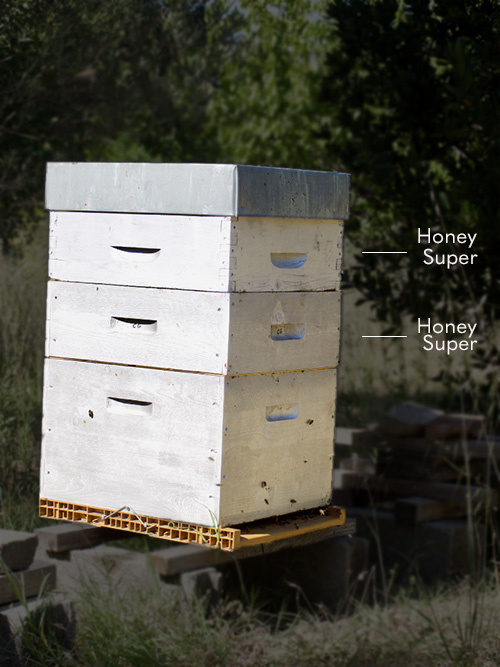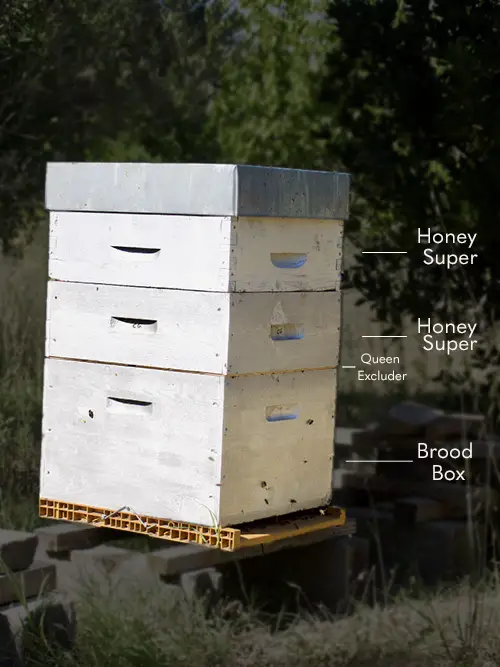When I first started beekeeping, there were a lot of new terms I had to learn that I found confusing. Two of these were ‘super’ and ‘brood box’.
These terms are used often because they describe where the bees and queen live, the brood is raised and the honey is stored. Where most of the action ‘happens’ is in either the brood box or honey super.
But what does each term refer to? And what is the difference between the two?

Brood Box Vs Honey Super
A Langstroth Hive (the most commonly-used beehive in the U.S) is made up of smaller parts, the majority of which are similarly proportioned boxes stacked on top of each other. Each one of these boxes is either referred to as a brood box or a super, depending on what it is used for.
A brood box is the box that’s used to house both the queen and the brood. It typically sits on the bottom of the hive and forms the base of the structure. A super, on the other hand, usually contains just honey (though it can contain brood as well if a queen excluder is not used). It is often therefore referred to as a honey super.
What Is A Super?
The word ‘super’, in beekeeping terms, is short for ‘superstructure’.
A superstructure is an upward extension of an existing structure. Think of it like adding an upper story to your single story home. The bottom level is the structure, and the additional levels become part of the superstructure.
The same is true in a beehive. The base (or structure) is almost always the brood box. Therefore, every additional box that is added is referred to as a super, because it forms part of the superstructure.
A ‘super’ is also sometimes to referred to as a ‘honey super’, because they are used almost exclusively to store honey.
A super typically comes in 3 different sizes – deep, medium and shallow. A deep super is 9 and 5/8 inch tall, medium super is 6 and 5/8 inch tall, and a shallow super is 5 and 3/4 inch tall.
They house either ten or eight frames of wax foundation, depending on whether they are for an 8-frame Langstroth hive or a 10-frame Langstroth hive. These frames are used by bees to build comb and store honey.
A honey super is usually of a shallower depth than the brood box because when a honey super is full of capped honey it’s extremely heavy to lift. Therefore many beekeepers prefer to use two shallower supers rather than a single deep one. It gives them the flexibility to add additional supers in Spring when the bees store a lot of honey.

You should make sure all of your supers are the same depth as this allows you to interchange frames between each one. My honey supers are medium depth so I can more easily lift and maneuver them.
You can use as many supers on your hive as your colony needs – something that will be determined by where you live, your local weather patterns and the amount and type of flora available.
In Spring and Summer when the weather is warmer and there is more food available your colony will expand and need extra space for brood and honey storage. That’s the time to add one or more supers above your brood box, as many as your colony needs.
In Autumn and Winter when the weather becomes cooler, the queen lays fewer eggs and not as much honey is stored. The colony cannot keep the brood box and supers warm during the cold weather. That’s the time to reduce the size of your hive by removing one or more of the supers above your brood box.
In order for the bees to use the super exclusively for honey (as opposed to both honey and brood), a queen excluder needs to be placed between the brood box and the honey super. Otherwise the queen may lay eggs in the honey super and then the honey can’t be harvested because it will be contaminated by brood.
A frame that has once had brood in it can’t be used as a honey super because the cells have had bee larvae in them and there may be remnants of baby bees left in the cells and your honey will be affected.
However, you can use a honey frame in your brood box. The bees will utilize the remaining honey, and clean out the cell ready for the queen to lay in it.
What Is A Brood Box?
A brood box, or brood chamber as it’s sometimes called, is a box that’s used exclusively by the queen to lay eggs, or brood. It can either house eight or ten frames, depending on the size, with the frames nearest the two sides usually housing honey.
A brood box is usually of maximum depth to allow the queen plenty of room to lay eggs.

A brood box, or boxes, will form the base of your hive, with a board that has an entrance for the bees to come and go.
Depending on the strength of your colony, more than one brood box may be used. Often a second brood box is added in early Spring to give the bees more room, which reduces the impulse to swarm.
The super or supers are placed above the brood box.
Conclusion
As a new beekeeper there are many things for you to learn and understand about beekeeping and sometimes it can be very confusing.
When I first decided that I wanted to become a beekeeper, I found some of the terminology confusing. By doing a bit of reading and researching on the internet, I was able to learn more.
By far the best way to learn for me was to talk with an experienced beekeeper and attend meetings of my local bee club. That way I could learn in a hands on fashion about brood boxes and supers and other things associated with beekeeping.
